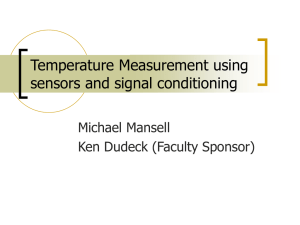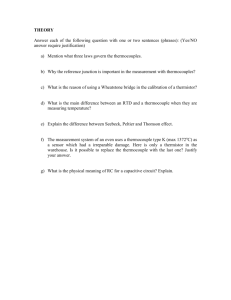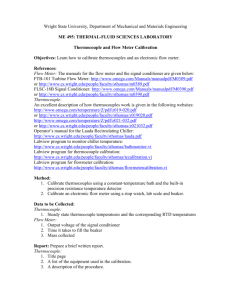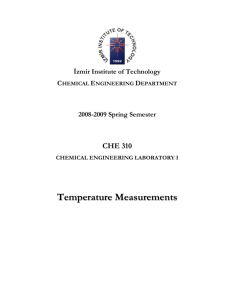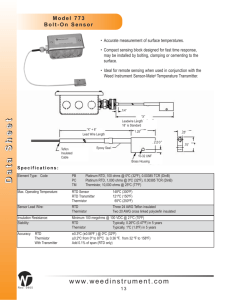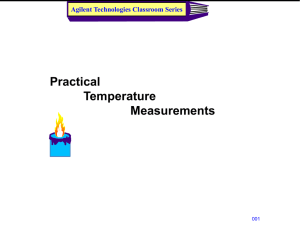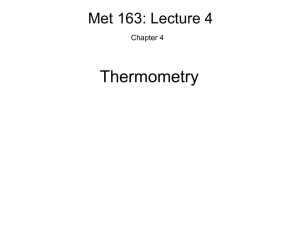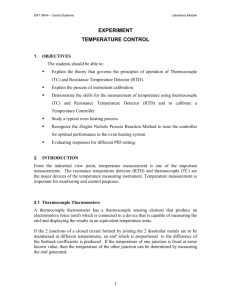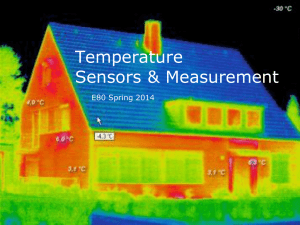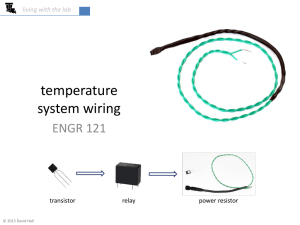thermistor
advertisement
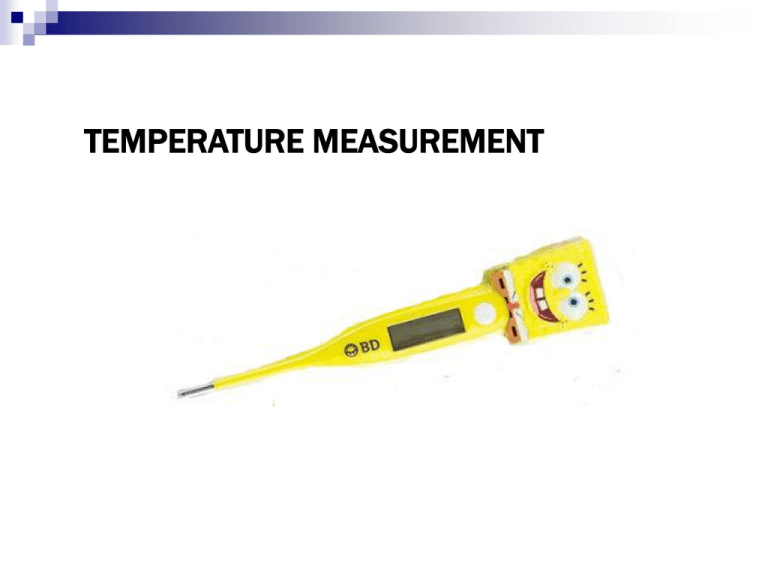
TEMPERATURE MEASUREMENT
CONTENTS
•INTRODUCTION
•RESISTANCE TEMPERATURE DETECTOR (RTD)
•THERMISTOR
•THERMOCOUPLE
•CALIBRATION METHOD
INTRODUCTION
TEMPERATURE UNLIKE OTHER QUANTITIES (LENGTH, TIME, MASS)
IS AN ABSTRACT QUANTITY THAT MUST BE DEFINED IN TERMS
OF THE BEHAVIOUR OF MATERIALS AS THE TEMPERATURE CHANGES
TEMPERATURE CHANGE
CHANGE IN VOLUME OF LIQUID
CHANGE IN LENGTH OF BAR
CHANGE IN ELECTRICAL RESISTANCE
OF A WIRE
CHANGE IN PRESSURE OF GAS AT
CONSTANT VOLUME
ETC
MATERIAL
BEHAVIOUR
CONTENTS
•INTRODUCTION
•RESISTANCE TEMPERATURE DETECTOR (RTD)
•THERMISTOR
•THERMOCOUPLE
•CALIBRATION METHOD
RESISTANCE THERMOMETERS
CONSISTS OF A SENSOR ELEMENT THAT EXHIBITS A CHANGE
IN RESISTANCE WITH A CHANGE IN TEMPERATURE, A SIGNAL
CONDITIONING THAT CONVERTS THE RESISTANCE CHANGE
TO AN OUTPUT VOLTAGE AND INSTRUMENTATION TO RECORD
AND DISPLAY THE OUTPUT VOLTAGE
TYPES OF SENSOR USED:
•RESISTANCE TEMPERATURE DETECTOR (RTD)
SIMPLE RESISTIVE ELEMENTS FORMED OF SUCH MATERIALS
AS PLATINUM, NICKEL, OR NICKEL-COPPER ALLOY BECAUSE
THEY EXHIBIT A POSITIVE COEFFICIENT OF RESISTIVITY, STABLE
GOOD REPRODUCIBILITY
•THERMISTOR
FABRICATED FROM SEMICONDUCTION MATERIALS, SUCH AS
OXIDES OF MANGANESE, NICKEL OR COBALT
EXHIBIT A HIGH NEGATIVE COEFFICIENT OF RESISTIVITY
RTD
Resistance-Temperature relationship
RT=Ro{1+a[T-d(0.01T-1)(0.01T)-b(0.01T-1)(0.01T)3]}
(Calendar-Van Dusen equation)
where a, b and d are constants determined by calibration
T is temperature in degrees Celcius
Ro is a resistance at reference temperature (usually 00C)
a=0.003921/0C , d=1.49 and b=0 for T>0, b =0.11 for T<0 (US calibration)
Advantages using RTD
•Platinum RTDs are more accurate than thermocouples
•Output response is more linear
US Calibration of Platinum RTD: R versus T
RTD instrumentation
Wheatstone bridge for RTD
Three wire
Two wire
Assume resistance
of two wires low,
R1=R4
RTD R2
Vsupply 2Vo
Vsupply 2Vo
Four wire
R1=R4, if lead wire resistance
is not neglected, the change
in lead resistance cancelled each
other
RTD R2
Vsupply 2Vo
Vsupply 2Vo
Rlead
RTD R3
4Vo
Vsupply 2Vo
Vsupply 2Vo
Vsupply 2Vo
Rlead
8Vo
Vsupply 2Vo
Example:
An RTD probe has a resistance of 100 W at 00C. The Calendar-Van Dusen
constants are a=0.00392, d=1.49 and b=0 for T>00C. What will be the
resistance at 3500C?
Solution:
RT=Ro{1+a[T-d(0.01T-1)(0.01T)-b(0.01T-1)(0.01T)3]}
if all variables are put into this equation
RT=232.08 W
or from calibration table we have 231.89 W
CONTENTS
•INTRODUCTION
•RESISTANCE TEMPERATURE DETECTOR (RTD)
•THERMISTOR
•THERMOCOUPLE
•CALIBRATION METHOD
THERMISTOR
Resistance Temperature relationship
1 1
R R0 exp b
T T0
where:
R=resistance at any temperature T, in K
R0= resistance at reference temperature T0, in K
b=a constant, in K
Generally respond to an increase in temperature with a decrease in resistance
Using semiconductor
b depends on thermistor material, typically between 1000-5000 K for metal
oxide thermistor
Thermistor Instrumentation
Since the change in resistance for thermistor is so large (DR/R=80W/K)
a common multimeter (4 digits) can be employed to measure R within ± 1 W,
no bridge required
V
RT
I
If using DAQ with computing microprocessor,
temperature can be approximated
very closely using Steinhart-Hart relation
1
A B ln RT C (ln RT )3
T
Where A, B and C are coefficients
determined from calibration curve
CONTENTS
•INTRODUCTION
•RESISTANCE TEMPERATURE DETECTOR (RTD)
•THERMISTOR
•THERMOCOUPLE
•CALIBRATION METHOD
THERMOCOUPLE
Seebeck Effect
Temperature gradient between two conductors induces a voltage potential
where
(sometimes a0 is used) is average Seebeck coefficient at T1≤T≤T2
Thermocouple is a simple temperature sensor consists of two dissimilar
materials in thermal contact
Thermocouple are only capable of
measuring temperature differences.
To measure the temperature of an
object, we need a known reference
temperature. The thermocouple is
used to measure the temperature
difference between the object and
the known temperature
Law of intermediate metals
EXAMPLE
A type R thermocouple system with an ice reference has an output
of 9.1 mV. What is the temperature of the sensing junction?
Solution:
In table, for R type thermocouple, 7.949 mV corresponds to 8000C and
9.203 corresponds to 9000C. Linear interpolation gives a temperature of
891.80C for 9.1 mV.
Example:
An iron constantan thermocouple is connected to a potentiometer whose
terminals are 250C. The potentiometer reading is 3.59 mV. What is
the temperature of the thermocouple junction?
Solution:
The thermoelectric potential corresponding to 250C from table is
E25oC=1.277 mV
The emf of the thermocouple based on a 00C reference temperature is
ET=1.277+3.59=4.867 mV
Which corresponds to 92.50C temperature
For laboratory work reference temperature usually forced to 00C
using ice bath
